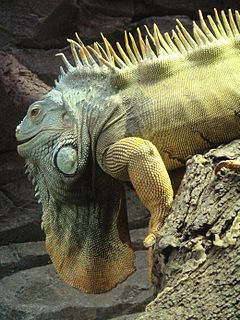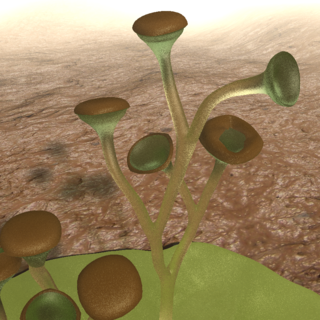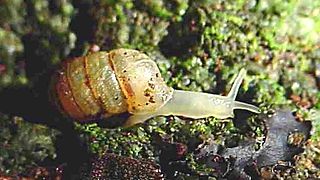Related Research Articles

The family Alligatoridae of crocodylians includes alligators and caimans.

Vespertilionidae is a family of microbats, of the order Chiroptera, flying, insect-eating mammals variously described as the common, vesper, or simple nosed bats. The vespertilionid family is the most diverse and widely distributed of bat families, specialised in many forms to occupy a range of habitats and ecological circumstances, and it is frequently observed or the subject of research. The facial features of the species are often simple, as they mainly rely on vocally emitted echolocation. The tails of the species are enclosed by the lower flight membranes between the legs. Over 300 species are distributed all over the world, on every continent except Antarctica. It owes its name to the genus Vespertilio, which takes its name from a word for bat, vespertilio, derived from the Latin term vesper meaning 'evening'; they are termed "evening bats" and were once referred to as "evening birds".

The Iguanidae are a family of lizards composed of iguanas and related species which includes species such as the Green Iguana, the Lesser Antillean Iguana and the marine iguana.

In zoological nomenclature, a type species is the species name with which the name of a genus or subgenus is considered to be permanently taxonomically associated, i.e., the species that contains the biological type specimen(s). A similar concept is used for suprageneric groups and called a type genus.

Croton is an extensive flowering plant genus in the spurge family, Euphorbiaceae. The plants of this genus were described and introduced to Europeans by Georg Eberhard Rumphius. The common names for this genus are rushfoil and croton, but the latter also refers to Codiaeum variegatum. The generic name comes from the Greek κρότος, which means "tick" and refers to the shape of the seeds of certain species.

Cooksonia is an extinct group of primitive land plants, treated as a genus, although probably not monophyletic. The earliest Cooksonia date from the middle of the Silurian ; the group continued to be an important component of the flora until the end of the Early Devonian, a total time span of 433 to 393 million years ago. While Cooksonia fossils are distributed globally, most type specimens come from Britain, where they were first discovered in 1937. Cooksonia includes the oldest known plant to have a stem with vascular tissue and is thus a transitional form between the primitive non-vascular bryophytes and the vascular plants.

Bettongs, species of the genus Bettongia, are potoroine marsupials once common in Australia. They are important ecological engineers displaced during the colonisation of the continent, and are vulnerable to threatening factors such as altered fire regimes, land clearing, pastoralism and introduced predatory species such as the fox and cat.
Dormer's bat or Dormer's pipistrelle is a species of vesper bat. It is monotypical for its genus.

Cylindraspis is a genus of recently extinct giant tortoises. All of its species lived in the Mascarene Islands in the Indian Ocean and all are now extinct due to hunting and introduction of non-native predators.
Craspedopoma costatum is a species of tropical land snail with an operculum, terrestrial gastropod mollusks in the family Craspedopomatidae. This species is endemic to Spain.
Craspedopoma hespericum is a species of tropical land snails with an operculum, terrestrial gastropod mollusks in the family Craspedopomatidae. This species is endemic to Portugal.
Craspedopoma lyonnetianum is a species of tropical land snails with an operculum, terrestrial gastropod mollusks in the family Craspedopomatidae.
Craspedopoma trochoideum is a species of tropical land snails with an operculum, terrestrial gastropod mollusks in the family Craspedopomatidae.

Streptaxidae is a family of carnivorous air-breathing land snails, terrestrial pulmonate gastropod mollusks in the clade Stylommatophora. Six Streptaxidae subfamilies are accepted in the 2005 taxonomy of the Gastropoda by Bouchet & Rocroi.

Camaenidae is a family of air-breathing land snails, terrestrial pulmonate gastropod mollusks in the superfamily Helicoidea, the typical snails and their allies. This is one of the most diverse families in the clade Stylommatophora.

In biological classification, taxonomic rank is the relative level of a group of organisms in a taxonomic hierarchy. Examples of taxonomic ranks are species, genus, family, order, class, phylum, kingdom, domain, etc.

Cyclotosaurus is an extinct genus of temnospondyl within the family Mastodonsauridae. It was of great size for an amphibian, reaching 3–4.3 m (9.8–14.1 ft) in length with an elongated 70 cm (28 in) skull.
Craspedopomatidae is a family of very small land snails with a gill and an operculum, terrestrial gastropod mollusks in the informal group Architaenioglossa belonging to the clade Caenogastropoda.

Chelonoidis is a genus of turtles in the tortoise family erected by Leopold Fitzinger in 1835. They are found in South America and the Galápagos Islands, and formerly had a wide distribution in the West Indies.
Dasypterus is a genus of or subgenus of vesper bat. As a genus, it includes species that were formerly in the genus Lasiurus. Collectively, members of Dasypterus are referred to as the yellow bats.
References
- ↑ Descriptions of 38 new species of land-shells, in the collection of Hugh Cuming, Esq. L Pfeiffer, Proceedings of the Zoological Society of London, 1847
- ↑ Miller, K. (1907). Alttertiäre Land- und Süßwasserschnecken der Ulmer Gegend. Jahreshefte des Vereins für vaterländische Naturkunde in Württemberg. volume 63, page 451, pl. 9, fig. 1